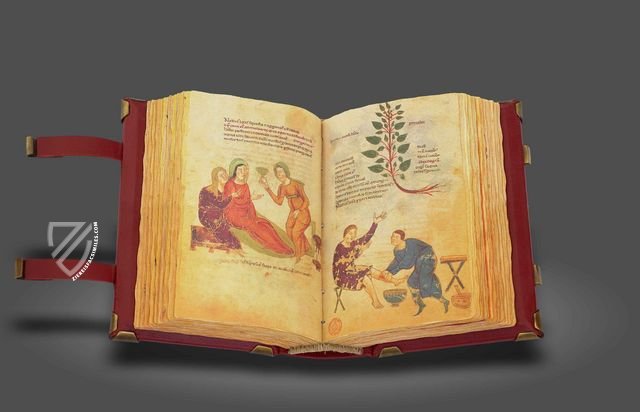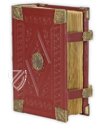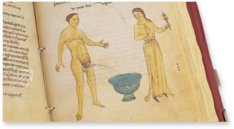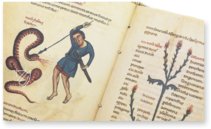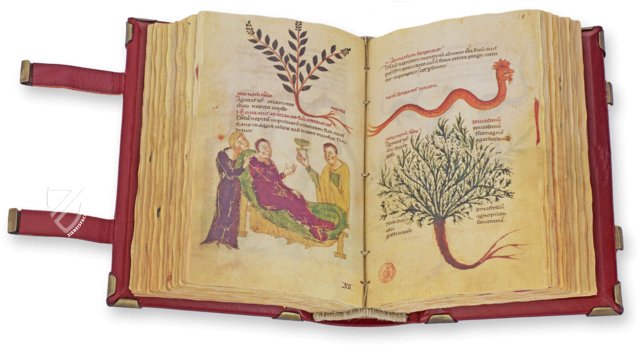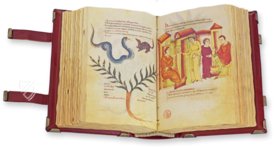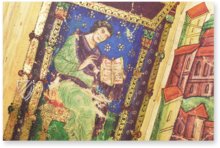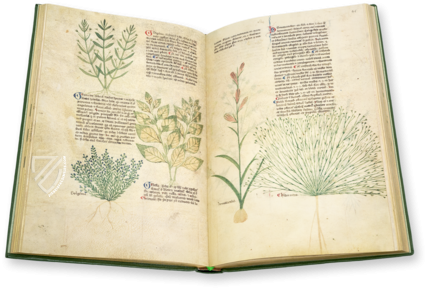Codex of Medicine of Frederick II
(3,000€ - 7,000€)
Sometime about the middle of the 13th century, Frederick II (1194–1250), the Holy Roman Emperor from the Hohenstaufen dynasty, commissioned this fascinating medical handbook. The Codex of Medicine of Frederick II is a wonderful testament to the state of high medieval medicine in southern Italy at the time, but also to the Emperor's promotion of science and culture. He was one of the most educated rulers of medieval Europe and a great patron of the famous school of Salerno, a center of medicine. As was usual at the time, his valuable Codex of Medicine was compiled from various medical texts, including several writings by Pseudo-Apuleius. The diseases, treatment methods, remedies and medicinal plants described therein are illustrated and supported by over 500 diverse miniatures. They include botanical plant depictions, symbolic animal images and therapeutic scenes, as well as magnificent portraits of medical authorities such as Hippocrates, Plato and Dioscorides.
Codex of Medicine of Frederick II
The comprehensive, small Codex of Medicine of Frederick II likely arose in mid–13th century Italy. The Emperor had an exceptional interest in science and commissioned the pharmacopoeia in order to make an entertaining and simultaneously instructive work, which cataloged knowledge concerning the healing effects of herbs and other remedies and treatments. There are various medical texts collected within the Codex of Medicine by the so-called Pseudo-Apuleius alongside other works on pharmaceutics. Richly illustrated, the text and wondrous miniatures describe different illnesses and cures alongside numerous depictions of plants.
A Glimpse in the Medical Treatment of the Middle Ages
Various illnesses with their consequences are pictorially depicted in a wonderful, lively way and are placed in connection with the corresponding treatment. Therefore, not only are the type and dosage of the drugs described, but the environment in which the medical treatment was normally carried out is also depicted. The patients lie in their beds, holding their feet in a small bath, or are treated in other, often bizarre ways. The attending doctors distribute medicine and impart upon the reader the therapeutic applications, which the dose and manner of application of healing herbs and plants require. For example, in an illustration of healing a snake bite is shown to be remedied with verbena.
Botanical Depictions and Shiny Gold Miniatures
These plants are reproduced in detail over countless pages throughout the manuscript, and are often placed in connection with symbolic depictions of animals and mythical images. In addition to these miniatures without a direct connection to the text, there are also full-page miniature pages in the manuscript. For example, there is a miniature page with a depiction of Hippocrates flanked by Plato and Dioscorides. Framed in a border with luxuriant golden décor and ornamentally designed figures of backgrounds, the pictures have a Byzantine aesthetic. This stems from their creation in Southern Italy. A total of 510 miniatures across 460 pages give a wondrous and striking overview of the status of medicine and healing in the 13th century.
An Emperor’s Pharmacopoeia
The Codex of Medicine of Frederick II features content that varies between mythical and popular scientific knowledge. The knowledge within the book is compiled from a collection of sources from the Late Antiquity, which by the Middle Ages had been widely distributed throughout Europe and enjoyed great influence. One finds texts from the herbarium of the Pseudo-Dioscorides, the Medicinis ex libris feminis et masculinis, as well as other collected works. Frederick II (1194–1250), the Holy Roman Emperor from the Hohenstaufen dynasty, was the patron of the manuscript. His court was considered to be the center for science and culture, and he himself was known to be an enthusiastic scientist. Frederick II was the most educated ruler of his time. He had a burning passion for medicine as an applied science. It comes as no surprise that he was the founder of the Salerno School of Medicine, wherefrom countless pharmaceutical books would arise. Additionally, he settled the separation of doctors and pharmacists as professions in a game-changing law, and required that they be licensed. Therefore, this grandly designed medical text fits perfectly into the interests of this famous, influential, and erudite Emperor.
Codicology
- Alternative Titles
- Códice sobre Medicamentos de Federico II
Die Medikamenten-Lehre Friedrichs II.
Arneibuch Friedrichs II.
Codex sur les Médicaments de Frédéric II
Codice sui Medicinali di Federico II
Códice sobre Medicamentos de Federico II
Medical Miscellany - Size / Format
- 460 pages / 17.6 × 11.5 cm
- Origin
- Italy
- Date
- 13th century
- Style
- Illustrations
- 510 miniatures in the mid-Byzantine style
- Patron
- Emperor Frederick II (1194 – 1250)
Codex of Medicine of Frederick II
Plato
Dressed in green and purple in front of a blue background and surrounded by a glimmering golden architecture, Plato is identified by the text of the codex he is holding. The 5th century BC Athenian philosopher is depicted in the manuscript along with his contemporary Hippocrates, the “Father of Medicine”, and Dioscorides, the Greek physician in the Roman army who built on Hippocrates’ work and during the years AD 50-70 wrote the authoritative text on pharmacology for the next 1,500 years.

Codex of Medicine of Frederick II
Treating Shingles
Shingles is a viral disease causing painful rashes and blisters on the skin, which can last for weeks. Not only is it related to the childhood disease chickenpox, but shingles is actually a reactivation of the virus. Of course, this advanced knowledge of the inner workings of the affliction was unknown to medieval physicians, who instead focused on treating the symptoms.
Just like modern patients, a medieval person afflicted with shingles was first and foremost concerned with alleviating its painful rashes and blisters because a vaccine was many centuries away. Chamomile, oregano, and other plants were used to create a soothing balm, which is shown here being applied to the red-spotted legs of the patient by a kneeling physician in a green tunic.

#1 Códice sobre Medicamentos de Federico II
Languages: Spanish, English
(3,000€ - 7,000€)
- Treatises / Secular Books
- Apocalypses / Beatus
- Astronomy / Astrology
- Bestiaries
- Bibles / Gospels
- Chronicles / History / Law
- Geography / Maps
- Saints' Lives
- Islam / Oriental
- Judaism / Hebrew
- Single Leaf Collections
- Leonardo da Vinci
- Literature / Poetry
- Liturgical Manuscripts
- Medicine / Botany / Alchemy
- Music
- Mythology / Prophecies
- Psalters
- Other Religious Books
- Games / Hunting
- Private Devotion Books
- Other Genres
- Afghanistan
- Armenia
- Austria
- Belgium
- Belize
- Bosnia and Herzegovina
- China
- Colombia
- Costa Rica
- Croatia
- Cyprus
- Czech Republic
- Denmark
- Egypt
- El Salvador
- Ethiopia
- France
- Germany
- Greece
- Guatemala
- Honduras
- Hungary
- India
- Iran
- Iraq
- Israel
- Italy
- Japan
- Jordan
- Kazakhstan
- Kyrgyzstan
- Lebanon
- Liechtenstein
- Luxembourg
- Mexico
- Morocco
- Netherlands
- Palestine
- Panama
- Peru
- Poland
- Portugal
- Romania
- Russia
- Serbia
- Spain
- Sri Lanka
- Sweden
- Switzerland
- Syria
- Tajikistan
- Turkey
- Turkmenistan
- Ukraine
- United Kingdom
- United States
- Uzbekistan
- Vatican City
- A. Oosthoek, van Holkema & Warendorf
- Aboca Museum
- Ajuntament de Valencia
- Akademie Verlag
- Akademische Druck- u. Verlagsanstalt (ADEVA)
- Aldo Ausilio Editore - Bottega d’Erasmo
- Alecto Historical Editions
- Alkuin Verlag
- Almqvist & Wiksell
- Amilcare Pizzi
- Andreas & Andreas Verlagsbuchhandlung
- Archa 90
- Archiv Verlag
- Archivi Edizioni
- Arnold Verlag
- ARS
- Ars Magna
- ArtCodex
- AyN Ediciones
- Azimuth Editions
- Badenia Verlag
- Bärenreiter-Verlag
- Belser Verlag
- Belser Verlag / WK Wertkontor
- Benziger Verlag
- Bernardinum Wydawnictwo
- BiblioGemma
- Biblioteca Apostolica Vaticana (Vaticanstadt, Vaticanstadt)
- Bibliotheca Palatina Faksimile Verlag
- Bibliotheca Rara
- Boydell & Brewer
- Bramante Edizioni
- Bredius Genootschap
- Brepols Publishers
- British Library
- C. Weckesser
- Caixa Catalunya
- Canesi
- CAPSA, Ars Scriptoria
- Caratzas Brothers, Publishers
- Carus Verlag
- Casamassima Libri
- Centrum Cartographie Verlag GmbH
- Chavane Verlag
- Christian Brandstätter Verlag
- Circulo Cientifico
- Club Bibliófilo Versol
- Club du Livre
- CM Editores
- Collegium Graphicum
- Collezione Apocrifa Da Vinci
- Comissão Nacional para as Comemorações dos Descobrimentos Portugueses
- Coron Verlag
- Corvina
- CTHS
- D. S. Brewer
- Damon
- De Agostini/UTET
- De Nederlandsche Boekhandel
- De Schutter
- Deuschle & Stemmle
- Deutscher Verlag für Kunstwissenschaft
- DIAMM
- Droz
- E. Schreiber Graphische Kunstanstalten
- Ediciones Boreal
- Ediciones Grial
- Ediclube
- Edições Inapa
- Edilan
- Editalia
- Edition Deuschle
- Edition Georg Popp
- Edition Leipzig
- Edition Libri Illustri
- Editiones Reales Sitios S. L.
- Éditions de l'Oiseau Lyre
- Editions Medicina Rara
- Editorial Casariego
- Editorial Mintzoa
- Editrice Antenore
- Editrice Velar
- Edizioni Edison
- Egeria, S.L.
- Eikon Editores
- Electa
- Emery Walker Limited
- Enciclopèdia Catalana
- Eos-Verlag
- Ephesus Publishing
- Ernst Battenberg
- Eugrammia Press
- Extraordinary Editions
- Fackelverlag
- Facsimila Art & Edition
- Facsimile Editions Ltd.
- Facsimilia Art & Edition Ebert KG
- Faksimile Verlag
- Feuermann Verlag
- Folger Shakespeare Library
- Franco Cosimo Panini Editore
- Friedrich Wittig Verlag
- Fundación Hullera Vasco-Leonesa
- G. Braziller
- Gabriele Mazzotta Editore
- Gebr. Mann Verlag
- Gesellschaft für graphische Industrie
- Getty Research Institute
- Giovanni Domenico de Rossi
- Giunti Editore
- Graffiti
- Grafica European Center of Fine Arts
- Guido Pressler
- Guillermo Blazquez
- Gustav Kiepenheuer
- H. N. Abrams
- Harrassowitz
- Harvard University Press
- Helikon
- Hendrickson Publishers
- Henning Oppermann
- Herder Verlag
- Hes & De Graaf Publishers
- Hoepli
- Holbein-Verlag
- Houghton Library
- Hugo Schmidt Verlag
- Idion Verlag
- Il Bulino, edizioni d'arte
- ILte
- Imago
- Insel Verlag
- Insel-Verlag Anton Kippenberger
- Instituto de Estudios Altoaragoneses
- Instituto Nacional de Antropología e Historia
- Introligatornia Budnik Jerzy
- Istituto dell'Enciclopedia Italiana - Treccani
- Istituto Ellenico di Studi Bizantini e Postbizantini
- Istituto Geografico De Agostini
- Istituto Poligrafico e Zecca dello Stato
- Italarte Art Establishments
- Jan Thorbecke Verlag
- Johnson Reprint Corporation
- Josef Stocker
- Josef Stocker-Schmid
- Jugoslavija
- Karl W. Hiersemann
- Kasper Straube
- Kaydeda Ediciones
- Kindler Verlag / Coron Verlag
- Kodansha International Ltd.
- Konrad Kölbl Verlag
- Kurt Wolff Verlag
- La Liberia dello Stato
- La Linea Editrice
- La Meta Editore
- Lambert Schneider
- Landeskreditbank Baden-Württemberg
- Leo S. Olschki
- Les Incunables
- Liber Artis
- Library of Congress
- Libreria Musicale Italiana
- Lichtdruck
- Lito Immagine Editore
- Lumen Artis
- Lund Humphries
- M. Moleiro Editor
- Maison des Sciences de l'homme et de la société de Poitiers
- Manuscriptum
- Martinus Nijhoff
- Maruzen-Yushodo Co. Ltd.
- MASA
- Massada Publishers
- McGraw-Hill
- Metropolitan Museum of Art
- Militos
- Millennium Liber
- Müller & Schindler
- Nahar - Stavit
- Nahar and Steimatzky
- National Library of Wales
- Neri Pozza
- Nova Charta
- Oceanum Verlag
- Odeon
- Orbis Mediaevalis
- Orbis Pictus
- Österreichische Staatsdruckerei
- Oxford University Press
- Pageant Books
- Parzellers Buchverlag
- Patrimonio Ediciones
- Pattloch Verlag
- PIAF
- Pieper Verlag
- Plon-Nourrit et cie
- Poligrafiche Bolis
- Presses Universitaires de Strasbourg
- Prestel Verlag
- Princeton University Press
- Prisma Verlag
- Priuli & Verlucca, editori
- Pro Sport Verlag
- Propyläen Verlag
- Pytheas Books
- Quaternio Verlag Luzern
- Reales Sitios
- Recht-Verlag
- Reichert Verlag
- Reichsdruckerei
- Reprint Verlag
- Riehn & Reusch
- Roberto Vattori Editore
- Rosenkilde and Bagger
- Roxburghe Club
- Salerno Editrice
- Saltellus Press
- Sandoz
- Sarajevo Svjetlost
- Schöck ArtPrint Kft.
- Schulsinger Brothers
- Scolar Press
- Scrinium
- Scripta Maneant
- Scriptorium
- Shazar
- Siloé, arte y bibliofilia
- SISMEL - Edizioni del Galluzzo
- Sociedad Mexicana de Antropología
- Société des Bibliophiles & Iconophiles de Belgique
- Soncin Publishing
- Sorli Ediciones
- Stainer and Bell
- Studer
- Styria Verlag
- Sumptibus Pragopress
- Szegedi Tudomànyegyetem
- Taberna Libraria
- Tarshish Books
- Taschen
- Tempus Libri
- Testimonio Compañía Editorial
- Thames and Hudson
- The Clear Vue Publishing Partnership Limited
- The Facsimile Codex
- The Folio Society
- The Marquess of Normanby
- The Richard III and Yorkist History Trust
- Tip.Le.Co
- TouchArt
- TREC Publishing House
- TRI Publishing Co.
- Trident Editore
- Tuliba Collection
- Typis Regiae Officinae Polygraphicae
- Union Verlag Berlin
- Universidad de Granada
- University of California Press
- University of Chicago Press
- Urs Graf
- Vallecchi
- Van Wijnen
- VCH, Acta Humaniora
- VDI Verlag
- VEB Deutscher Verlag für Musik
- Verlag Anton Pustet / Andreas Verlag
- Verlag Bibliophile Drucke Josef Stocker
- Verlag der Münchner Drucke
- Verlag für Regionalgeschichte
- Verlag Styria
- Vicent Garcia Editores
- W. Turnowski Ltd.
- W. Turnowsky
- Waanders Printers
- Wiener Mechitharisten-Congregation (Wien, Österreich)
- Wissenschaftliche Buchgesellschaft
- Wissenschaftliche Verlagsgesellschaft
- Wydawnictwo Dolnoslaskie
- Xuntanza Editorial
- Zakład Narodowy
- Zollikofer AG

